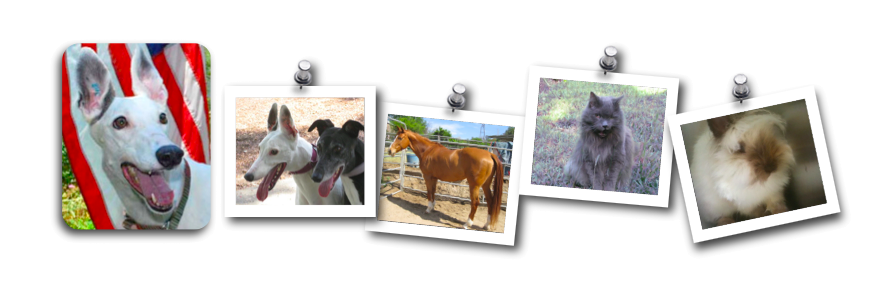The Dog Trainer : Leaving Your Dog Home Alone :: Quick and Dirty Tips ™Once upon a time, in the perhaps somewhat legendary past, dogs spent their days outdoors, working at their masters’ sides. Cue the theme from “Lassie.”
Tips for Leaving Your Dog Home Alone
These days, most of our dogs spend their people’s workdays at home alone. Often they’re bored and lonely. Fortunately, we can help that time pass easily -- without spending a lot of money.
Make ’Em Tired
The best thing you can do for your home-alone dog is supply some good, hard, first-thing-in-the-morning exercise. You saw that coming, right? How much exercise -- and what kind -- depends on your dog’s age, fitness, body type, and state of health, and also on the weather. Is your dog old, arthritic, and short-nosed, or is she an adolescent Border Collie mix? Is it 90 degrees out, 15, or 55? Check with your vet if you have questions about your dog’s exercise tolerance. The result you’re looking for is that your dog gets home and flops down on his bed to snooze. For most dogs, off-leash running, trotting, and sniffing are ideal, because they supply not only varied physical exercise, but mental stimulation as well.
Keep ’Em Busy
Next, put away your dog’s food bowl and use food-dispensing toys instead. Some toys--such as the Kong--can be stuffed. I often suggest a mixture of half canned and half dry food. For champion chewers, freeze the stuffed toy until it’s hard, so as to make a long-lasting excavation project. Other toys release dry food piece by piece when the dog knocks or pushes them around. Some of these toys offer variable difficulty levels, so you can frustrate your dog just enough to keep her active and engaged, like Grandma at the slots. Did you forget to wash out the food toys from the day before? Then take your dog’s entire breakfast ration of dry food and scatter it on the floor as you leave the house. Successful foraging is most dogs’ idea of a good time.
Do test-drive chew toys when you’re home and can supervise. Many food-dispensing toys will stand up to all but a minority of jaws, but others aren’t suited to hardcore chewers and may crack. If your dog can break the toy or chew pieces off, he and it need a chaperone. Rawhides and natural bones are also unsuitable for a solo dog.
Doggie Daycare and Dog Walkers
Daycare is a common suggestion for home-alone dogs. But many dogs don’t enjoy the company of their fellows, and many of us can’t afford the fees these days. If you can possibly spring for a daily dog walk, though, do it. Yes, many dogs are capable of holding their urine and feces all day long. But it’s not good for them. Dr. Marcela Salas, of Animal Kind Veterinary Hospital in Brooklyn, New York, explains that holding on for long periods can lead to urinary tract infections. And the highly concentrated urine a dog produces during a long wait can increase the likelihood of crystal formation and cystitis. Dr. Salas also points out that if your dog is old and creaky, she’ll benefit from getting up and taking a walk.
If you can’t afford a professional walker, trade favors with people. Maybe a job-hunting friend would like someone to drool on her bathrobe while she rewrites her resume for the dozenth time. Bake her some cupcakes when you get home. Or maybe your dog isn’t a candidate for daycare but does have canine friends. Can you trade a workday playdate for an extra Saturday afternoon walk?
Don’t Leave Your Dog Alone Outside
One idea I don’t endorse is leaving your dog out in the yard.
One idea I don’t endorse is leaving your dog out in the yard. Even assuming your fence is tall enough and dug deep enough to keep him from escaping no matter what, dogs left alone outside are vulnerable to intruders. Besides, a dog in the yard by himself isn’t keeping fit with calisthenics. At worst, he’s working on problem behaviors such as barking and lunging at passersby; at best, he’s hanging around by the back door hoping somebody will come and let him in again. Signs of Separation Anxiety
Finally, boredom, pent-up energy, and loneliness are one thing; separation anxiety’s another. Does your dog get restless and whiny as you prepare to leave? Does she gnaw at doors and windowsills while you’re away? Will he not eat when alone? These are a few of the behaviors associated with genuine separation anxiety. If they ring a bell, get competent, in-person help; usually, separation issues are best treated by combining appropriate medication with behavioral techniques.
Maybe someday we’ll all have dog-friendly workplaces and mass transit. Or perhaps be herding sheep and cows. Meanwhile, call me at 206-600-5661, or e-mail
dogtrainer@quickanddirtytips.com. I answer questions on Facebook, too – find me by searching for “The Dog Trainer.”


No comments:
Post a Comment